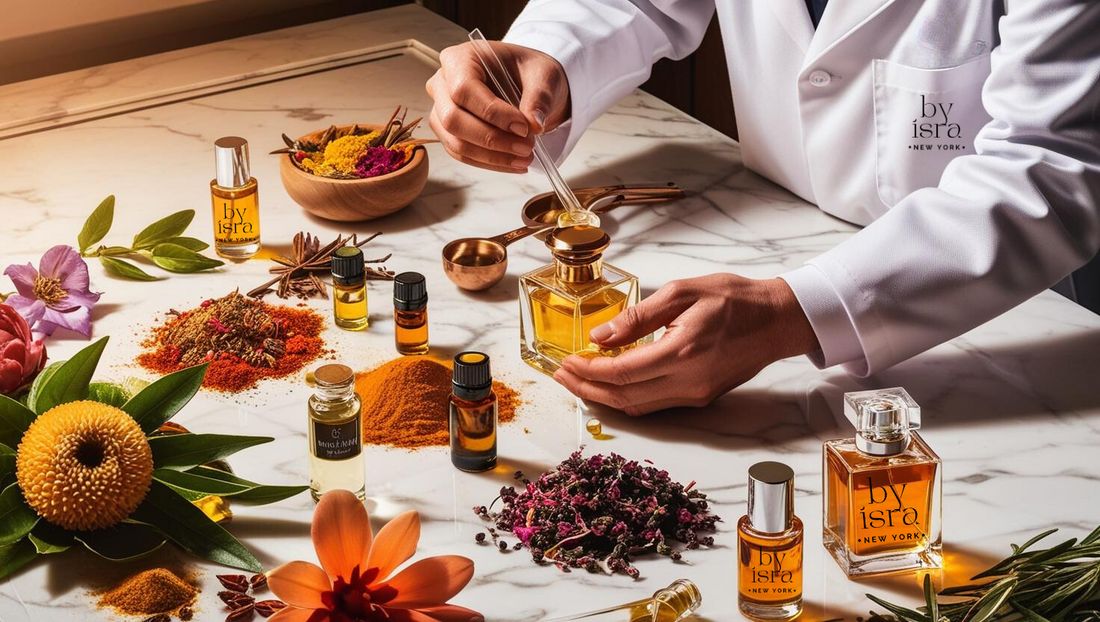
The Art of Perfume Making: Ingredients and Techniques
Klodian AbaziShare
The Key Ingredients in Perfume Making

- Natural Ingredients: Natural ingredients come from plant and animal sources. These include essential oils extracted from flowers (like rose or jasmine), leaves (such as patchouli or eucalyptus), fruits, and spices. Other ingredients such as musk were historically derived from animals, though ethical and synthetic alternatives are now used. The richness of natural ingredients often gives perfumes a depth and complexity that synthetic ingredients may lack. Fun fact: One kilogram of rose essential oil requires about 4,000 kilograms of petals!
- Synthetic Ingredients: Synthetics are used to create scents that are difficult to extract naturally or to replicate aromas that are rare or costly. For example, it’s almost impossible to extract lily-of-the-valley naturally, so this scent is often created using synthetic molecules. These man-made elements also allow for greater control over consistency and longevity, making them valuable for fragrance development.
- Fixatives: Fixatives stabilize the fragrance and ensure it lasts longer on the skin. Without them, the top notes of perfumes would evaporate too quickly. Natural fixatives like sandalwood or amber are often combined with synthetic molecules to create balanced, long-lasting scents.
The Perfumer’s Palette: Fragrance Families
- Floral: One of the most popular families, often associated with feminine fragrances. Ingredients like rose, jasmine, and lily are common.
- Woody: Dominated by warm, earthy notes like cedarwood, sandalwood, and patchouli. Woody fragrances evoke strength and sophistication.
- Fresh: Light and zesty, often incorporating citrus fruits, green herbs, and aquatic notes. Fresh scents are uplifting and often used in unisex perfumes.
- Oriental: Rich and sensual, often featuring spices like cinnamon or vanilla, and resins such as amber. These fragrances are deep and long-lasting.
- Fruity: These blends feature sweet, juicy notes like peach, apple, or berries. Fruity fragrances are lively and playful, often mixed with florals or fresh elements.
Perfume Structure: Top, Heart, and Base Notes
Fragrance creation is also structured around the concept of notes. Understanding the composition of top, heart, and base notes helps explain how perfumes evolve over time once applied.
- Top Notes: These are the initial scents you experience when you first apply a perfume. They are often light and fresh (like citrus or herbs) but evaporate quickly, lasting only about 15 minutes.
- Heart Notes: As the top notes fade, the heart (or middle) notes start to emerge. These are the core of the fragrance, lasting several hours, and include fuller scents like florals, spices, or fruits.
- Base Notes: The base notes are the foundation of the perfume and provide depth. They are rich, long-lasting ingredients such as amber, musk, or sandalwood, and can linger on the skin for hours, giving the fragrance its lasting character.
The Techniques Behind Perfume Making

Creating a perfume involves a delicate balance of art and science. Here are some of the key techniques used in the perfume-making process:
- Distillation: One of the oldest methods, distillation is used to extract essential oils from plants. In this process, steam passes through the plant material, capturing the aromatic oils. Once the steam cools, the oils are separated and collected.
- Extraction: This method involves using solvents to extract the desired fragrance compounds from delicate flowers or plant materials. It’s commonly used for flowers like jasmine, which are too delicate for distillation. The result is a waxy substance called a concrete, which is further processed into an absolute, a pure and concentrated form of fragrance.
- Maceration: Maceration involves soaking raw materials in a solvent (often alcohol) to draw out the aromatic compounds. This technique is used to extract more subtle notes from botanicals that require a gentle process.
- Blending: Once the raw materials are extracted, the perfumer carefully blends them in precise proportions. This stage is crucial as it determines the fragrance’s overall composition and harmony. Expert perfumers combine ingredients to achieve a perfect balance of top, heart, and base notes.
Conclusion
The art of perfume making is a delicate and intricate process that brings together the finest natural and synthetic ingredients, combined with centuries-old techniques and cutting-edge innovations. At By Isra New York, we are proud to uphold these traditions, offering perfumes that evoke emotions and leave a lasting impression.
Join us next week as we continue to explore the world of fragrance and dive into Understanding Fragrance Families: Floral, Woody, Spicy, and Fresh. Don’t forget to visit our website at www.byisranewyork.com to explore our signature scents and learn more about the craftsmanship behind our products.
